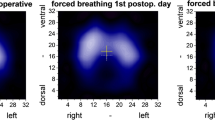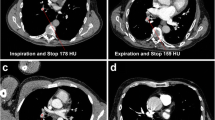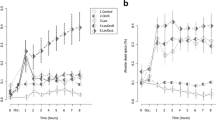Abstract
Pulmonary extravascular thermal volume (PETV) was measured during pulmonary artery occlusion in 18 patients preoperatively and 7 patients postoperatively who were undergoing pneumonectomy. We found that the PETV decreased from 6.6±2.3 ml·kg−1 before occlusion to 4.1±1.6 ml·kg−1 during occlusion. There was a significant correlation between the PETVs before and during occlusion multiplied by the fraction of pulmonary perfusion (r=0.77,P<0.001). Although the PETV increased in two patients and decreased in four within 48 h after pneumonectomy, it returned to the value during occlusion at 3 weeks after pneumonectomy in seven patients. There was a significant correlation between the PETV during occlusion and that at 3 weeks after pneumonectomy (r=0.66,P<0.05). In conclusion, PETV during pulmonary artery occlusion is a reliable baseline value in the assessment of postoperative pneumonectomy values.
Similar content being viewed by others
References
Kristersson S, Lindell S-E, Svanberg L (1972) Prediction of pulmonary function loss due to pneumonectomy using 133Xe-radiospiromentry. Chest 62:694–698
Olsen GN, Block AJ, Tobias JA (1974) Prediction of postpneumonectomy pulmonary function using quantitative macroaggregate lung scanning. Chest 66:13–16
Ali MK, Mountain CF, Ewer MS, et al. (1980) Predicting loss of pulmonary function after pulmonary resection for bronchogenic carcinoma. Chest 77:337–342
Nakahara K, Monden Y, Ohno K, et al. (1985) A method for predicting postoperative lung function and its relation to postoperative complications in patients with lung cancer. Ann Thorac Surg 39:260–265
Fry WA, Harrison RW, Moulder PV, et al. (1962) Serial study of postpneumonectomy state. Arch Surg 85:70–78
Zeldin RA, Normandin D, Landtwing D, et al. (1984) Postpneumonectomy pulmonary edema. J Thorac Cardiovasc Surg 87:359–365
Chinard FP, Enns T (1954) Transcapillary pulmonary exchange of water in the dog. Am J Physiol 178:197–202
Levine OR, Mellins RB, Fishman AP (1965) Quantitative assessment of pulmonary edema. Circ Res 17:414–426
Ramsy LH, Puckett W, Jose A, et al. (1964) Pericapillary gas and water distribution volumes of the lung calculated from multiple indicator dilution curves. Circ Res 15:275–286
O'Connor NE, Sheh J-M, Bartlett RH, et al. (1971) Changes in pulmonary extravascular water volume following mitral valve replacement. J Thorac Cardiovasc Surg 61:342–347
Byrick RJ, Kay JC, Noble WH (1977) Extravascular lung water accumulation in patients following coronary artery surgery. Can J Anaesth 24:332–345
Lewis FR, Elings VB, Sturm JA (1979) Bedside measurement of lung water. J Surg Res 27:250–261
Carlens E, Hanson HE, Nordenstrom B (1951) Temporary unilateral occlusion of the pulmonary artery. J Thorac Surg 22:527–536
Sloan H, Morris JD, Figley M, Lee R (1955) Temporary unilateral occlusion of the pulmonary artery in the preoperative evaluation of thoracic patients. J Thorac Surg 30:591–597
Nakada T, Furusawa A, Watabe A, et al. (1961) A study of the evaluation of lung function factors and their significance in practice especially for pulmonary surgery. Sci Rep Res Inst Tohoku Univ 11:1–19
Widimsky J (1970) Pressure, flow and volume changes of the lesser circulation during pulmonary artery occlusion in healthy subjects and patients with pulmonary hypertension. Progr Resp Res 5:224–236
Lewis FR, Elings VB (1978) Microprocessor determination of lung water using thermal-green dye double indicator dilution. Surg Forum 29:182–184
Brindley GV, Walsh RE, Schnarr WT, et al. (1982) Pulmonary resection in patients with impaired pulmonary function Surg Clin North Am 62:199–214
Luepker R, Liander B, Korsgren M, et al. (1971) Pulmonary intravascular and extravascular fluid volumes in exercising cardiac patients. Circulation 104:626–637
Boldt J, Kling D, Bormann BV, et al. (1987) Influence of cardiac output on thermal-dye extravascular lung water (EVLW) in cardiac patients. Intensive Care Med 13:310–314
Breen PH, Schumacker PT, Sandoval J, et al. (1985) Increased cardiac output increases shunt: role of pulmonary edema and perfusion. J Appl Physiol 59:1313–1321
Levine OR, Mellins RB, Senior RM, et al. (1967) The application of Starling's law of capillary exchange to the lungs. J Clin Invest 46:934–944
Mihm FG, Feeley TW, Rosenthal MH, et al. (1982) Measurement of extravascular lung water in dogs using the thermal-green dye indicator dilution method. Anesthesiology 57:116–122
Holcroft JW, Trunkey DD, Carpenter MA (1978) Excessive fluid administration in resuscitating baboons from hemorrhagic shock, and an assessment of the thermodye technique for measuring extravascular lung water. Am J Surg 135:412–416
Levine OR, Mellins RB, Senior RM (1970) Extravascular lung water and distribution of pulmonary blood flow in the dog. J Appl Physiol 28:166–171
Allison RC, Parker JC, Duncan CE, et al. (1983) Effect of air embolism on the measurement of extravascular lung thermal volume. J Appl Physiol 54:943–949
Beckett RC, Gray BA (1982) Effect of atelectasis and embolization on extravascular thermal volume of the lung. J Appl Physiol 53:1614–1619
Ali MK, Mountain C, Miller JM, et al. (1975) Regional pulmonary function before and after pneumonectomy using133Xenon. Chest 68:288–296
Author information
Authors and Affiliations
About this article
Cite this article
Sakuma, T., Nakada, T., Koike, K. et al. Preoperative estimation of pulmonary extravascular thermal volume in patients undergoing pneumonectomy. J Anesth 8, 6–11 (1994). https://doi.org/10.1007/BF02482744
Received:
Accepted:
Issue Date:
DOI: https://doi.org/10.1007/BF02482744




